语言学论文琳
英语语言学毕业论文

英语语言学毕业论文英语语言学毕业论文在当今全球化的时代,英语已经成为世界上最重要的语言之一。
因此,对于英语语言学的研究变得越来越重要。
本文将探讨英语语言学的一些重要概念和研究领域,以及其对我们理解语言和文化的影响。
首先,我们需要了解什么是语言学。
语言学是研究语言的科学,它涉及到语言的结构、语音、语法、语义以及语用等方面。
语言学家通过观察和分析语言的不同方面,试图了解语言的本质和运作方式。
在英语语言学中,语音学是一个重要的研究领域。
语音学家研究语音的产生、传播和感知。
他们关注音素、音位和音系等概念,以及不同语音之间的差异。
通过研究语音,我们可以更好地理解英语的发音规则和变体。
另一个重要的研究领域是语法学。
语法学家研究语言的句法结构和语法规则。
他们关注句子的组成和结构,以及不同句型之间的差异。
通过研究语法,我们可以更好地理解英语的句子构造和语法规则。
此外,语义学也是英语语言学的一个关键领域。
语义学家研究词汇和句子的意义。
他们关注词汇的定义、语义关系和概念的表示方式。
通过研究语义,我们可以更好地理解英语的词义和句子的意义。
除了以上几个研究领域,英语语言学还涉及到语用学、社会语言学和心理语言学等方面。
语用学研究语言在特定情境中的使用和交流。
社会语言学研究语言与社会文化因素之间的关系。
心理语言学研究语言的认知和心理过程。
这些研究领域相互交叉,共同帮助我们更全面地理解英语语言的本质和使用方式。
英语语言学的研究对我们的生活和社会有着深远的影响。
首先,它帮助我们更好地学习和教授英语。
通过研究语言的结构和规则,我们可以开发更有效的教学方法,帮助学生更好地掌握英语。
其次,它有助于我们理解不同语言和文化之间的差异。
通过比较不同语言的语音、语法和词汇等方面,我们可以更好地理解不同文化之间的差异和相似之处。
最后,它对翻译和跨文化交流也有着重要的意义。
研究语言学可以帮助我们更好地进行翻译和解释,促进不同文化之间的交流和理解。
英语语言学 毕业论文
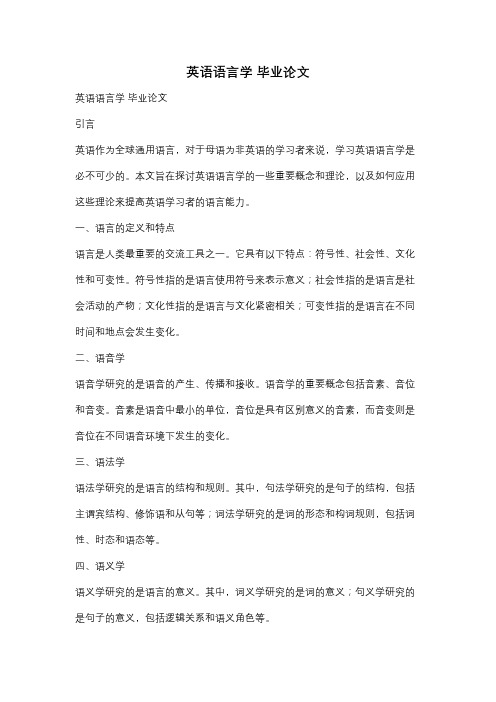
英语语言学毕业论文英语语言学毕业论文引言英语作为全球通用语言,对于母语为非英语的学习者来说,学习英语语言学是必不可少的。
本文旨在探讨英语语言学的一些重要概念和理论,以及如何应用这些理论来提高英语学习者的语言能力。
一、语言的定义和特点语言是人类最重要的交流工具之一。
它具有以下特点:符号性、社会性、文化性和可变性。
符号性指的是语言使用符号来表示意义;社会性指的是语言是社会活动的产物;文化性指的是语言与文化紧密相关;可变性指的是语言在不同时间和地点会发生变化。
二、语音学语音学研究的是语音的产生、传播和接收。
语音学的重要概念包括音素、音位和音变。
音素是语音中最小的单位,音位是具有区别意义的音素,而音变则是音位在不同语音环境下发生的变化。
三、语法学语法学研究的是语言的结构和规则。
其中,句法学研究的是句子的结构,包括主谓宾结构、修饰语和从句等;词法学研究的是词的形态和构词规则,包括词性、时态和语态等。
四、语义学语义学研究的是语言的意义。
其中,词义学研究的是词的意义;句义学研究的是句子的意义,包括逻辑关系和语义角色等。
五、语用学语用学研究的是语言在特定语境下的使用。
它关注的是语言的意图、目的和效果。
语用学的重要概念包括言外之意、语篇和会话分析。
六、二语习得二语习得是指母语为非目标语言的个体学习目标语言的过程。
二语习得的理论有很多,其中最著名的是克鲁斯卡尔的互补分布理论和斯蒂芬·克拉申的监控理论。
七、语言教学语言教学是将语言学理论应用于实际教学中。
语言教学方法有很多种,包括传统的文法翻译法、直接法、听说法和交际法等。
不同的教学方法适用于不同的学习者和教学环境。
八、语言变体和语言变异语言变体是指同一语言在不同社会群体中的变化。
它包括地区变体、社会变体和个人变体。
语言变异是指同一语言在不同时间和地点的变化。
语言变体和变异的研究对于理解语言变化和语言发展具有重要意义。
结论英语语言学是研究英语语言的科学,它涵盖了语音学、语法学、语义学、语用学、二语习得和语言教学等多个领域。
语言学研究论文范文分享与分析

语言学研究论文范文分享与分析随着社会的发展和国际交流的不断增加,语言学研究变得越来越重要。
在学术交流中,研究论文是学者们分享研究成果、交流思想的重要方式之一。
本文将分享一篇语言学研究论文的范文,并对其进行分析。
【正文正文正文】(这里开始进入正文,根据题目进行论述)首先,让我们来看一下这篇语言学研究论文的标题:"语言学研究中的音韵问题探讨"。
根据这个标题,可以确定这是一篇关于语言学中音韵问题的研究论文。
文章首先会对音韵问题的背景和研究意义进行介绍,并提出自己的研究目的和方法。
在论文的引言部分,作者简要介绍了音韵问题在语言学研究中的重要性,并提出了自己的研究假设。
接着,作者详细阐述了研究所用到的语料和方法。
通过收集一定数量的语音数据并运用统计学和计算机模拟等方法,作者试图验证自己的研究假设。
在论文的主体部分,作者对音韵问题进行了系统的分析和讨论。
论文采用了符合语言学研究规范的结构,通过引用前人的研究成果和相关理论,结合自己的实证研究结果,来支持自己的观点。
除了进行理论分析,作者还将自己的观察结果和数据进行统计分析,以证明自己的观点的可靠性和有效性。
值得注意的是,这篇论文的语言使用规范、准确,不涉及个人观点和主观判断,而是以客观事实和数据为论据,通过清晰的逻辑结构和恰当的语言表达来展示研究结果。
文章还采用了一些示意图和数据表格来辅助读者更好地理解和把握作者的研究成果。
在论文的结论部分,作者对研究结果进行总结,并提出了一些对未来研究的展望和建议。
这部分往往非常关键,因为它对整篇论文的研究价值和学术意义进行了总结和评价。
最后,在参考文献部分,作者列出了自己在研究过程中所引用的各种文献资料,包括书籍、期刊文章、学术报告等。
这部分的目的是让读者能够查找和了解作者所参考的文献来源,以便深入学习和研究。
通过对这篇语言学研究论文范文的分析,我们可以看出,一篇优秀的语言学研究论文应该具备以下几个方面的特点:明确的研究目的和假设、合理的研究方法和实证数据、准确的语言表达和清晰的逻辑结构、客观的研究结果和可靠的论据,以及充分的研究总结和展望。
英语语言学毕业论文范文

英语语言学毕业论文范文英语语言学毕业论文范文随着全球化的不断发展,英语作为一种国际语言的地位越来越重要。
因此,对英语语言学的研究也变得愈发重要。
本文将探讨英语语言学的一些重要概念和理论,并分析其在实际应用中的意义。
一、语言的定义和特征语言是人类最基本的交流工具,它通过声音、文字等形式传达信息。
语言学家对语言的定义有很多不同的观点,但大多数学者认为,语言是一种符号系统,通过符号来表示意义。
语言具有以下几个主要特征:1. 双重系统:语言既有音系(声音系统),也有词汇(词汇系统)。
音系是由语音和音位组成的,而词汇则是由词汇和语法组成的。
2. 有限性:语言的符号系统是有限的,但可以通过组合和变换来产生无限的表达方式。
3. 社会性:语言是社会的产物,它反映了人们的文化、价值观和社会地位。
二、语言的层次结构语言可以分为不同的层次结构,包括音位、词汇、句法和语义等。
音位是语言中最小的语音单位,词汇是由音位组成的,句法是词汇的组合规则,而语义则涉及词汇和句法的意义。
1. 音位:音位是语言中最基本的语音单位,它可以通过发音来区分不同的词汇。
英语中的音位包括元音和辅音。
2. 词汇:词汇是由音位组成的,它是语言中最基本的意义单位。
英语中的词汇包括名词、动词、形容词等。
3. 句法:句法是词汇的组合规则,它决定了词汇如何组合成句子。
英语中的句法包括主谓结构、宾语结构等。
4. 语义:语义涉及词汇和句法的意义,它研究词汇和句子的意义以及它们之间的关系。
英语中的语义包括词义、句义等。
三、语言变体和语言变异语言是活的,它会随着时间和地点的变化而发生变化。
语言变体是指同一种语言在不同的地区或社会群体中的变化,而语言变异则是指同一种语言在不同的语境中的变化。
1. 语言变体:英语作为一种全球性语言,它在不同的地区有不同的变体,如美式英语、英式英语等。
这些变体在发音、词汇和语法等方面都有所差异。
2. 语言变异:同一种语言在不同的语境中也会发生变异。
语言学论文

语言学论文引言语言学是一门研究人类语言系统及其规律的学科。
它涉及了语音学、语法学、语义学、语用学等各个方面的研究。
本论文旨在探讨语言学的基本概念、发展历程以及其在语言教学中的应用。
1. 语言学的基本概念1.1 语言学的定义语言学是指对语言进行研究的学科,它不仅包括对语言的结构、语音和语法等方面的研究,还涉及了语言发展、语言变异以及语言间的关系等问题。
1.2 语言学的分类根据研究的内容和方法,语言学可以分为多个子学科。
其中,语音学研究语音的产生、传播和接收过程;语法学研究句子的结构和构成要素之间的关系;语义学研究词义和句子意义的生成和理解规律;语用学研究语言在社交交际中的使用。
2. 语言学的发展历程语言学的研究可以追溯到古代,但作为一门独立的学科,它的发展起源于19世纪。
20世纪以来,语言学在理论和方法上有了长足的进步,出现了多个流派和学派。
2.1 结构主义语言学结构主义语言学是20世纪初期的一种主导流派。
它通过分析语言的内部结构和音素、词汇、句法等元素之间的关系来揭示语言的规律。
2.2 生成语法学生成语法学强调语言的生成过程,认为句子是通过一定的规则和原则从基本句法元素生成的。
这种方法启发了计算机科学家发展自然语言处理的技术。
2.3 语用学的兴起语用学的兴起使得语言研究不再局限于语言的结构,而是将语言与社会交际和语境结合起来考虑。
语用学的成果为实际语言应用领域带来了重要的启示。
3. 语言学在语言教学中的应用语言学的研究成果在语言教学中起到了重要的指导作用。
语言教学注重培养学习者的语言能力和交际能力,而语言学为教师提供了有关语法、词汇、语音等方面的理论知识和实践经验。
3.1 语音教学语言学对语音的研究使得语音教学更加科学和系统化。
教师可以根据语音学的知识教导学生正确的语音发音和口腔运动。
3.2 语法教学语法是语言的骨架,语言学的研究为语法教学提供了理论基础。
教师可以借助语法学的知识帮助学生掌握词类、句法结构、句子联接等语法知识。
语言学论文

语言学论文
语言学是一门研究语言的学科,涉及词汇、语法、语音、语义等方面。
本论文将探讨语言学的一些重要内容。
首先,语言学研究的一个重要方面是词汇。
词汇是语言中最基本的单位,是人们用来表示和交流意义的最小组成部分。
语言学家通过研究词汇的形成、组织和使用来了解语言的结构和功能。
词汇的研究还包括词汇表达的语音特点、词义变化和词汇的分类等。
其次,语法是语言学的另一个重要研究领域。
语法研究语言中的句子构造和词语之间的关系。
语法包括句法学、词法学和语用学等方面。
句法学研究句子的结构和语序规则,词法学则研究词语的形态变化和构词法等。
语用学则研究语言在实际使用中的交际功能和目的。
此外,语音学是语言学的一个重要分支,研究人类语音系统的属性和规律。
语音学家研究语音的产生、传播和接受过程,包括声音的产生器官、语音的声学特征和语音的知觉过程。
语音学的研究对于了解语言的声音表现形式和语音的书写系统有重要的意义。
最后,语义学是语言学的一个关键领域,研究语言的意义和表达方式。
语义学家研究语言中的词义、句义和篇章义。
他们研究词的意义、词义的扩展和限制、句子的真值和含义以及语篇的语用功能。
总之,语言学作为一门学科涵盖了词汇、语法、语音和语义等方面的研究。
通过对语言的研究,我们可以更好地理解人类语言的结构和功能,从而更好地掌握和运用语言。
语言学理论毕业论文

语言学理论毕业论文语言学理论毕业论文1一、引言1956年2月6日,国务院发出全面推广普通话的指示,定义普通话为“以北京语音为标准音,以北方话为基础方言,以典范的白话文著作为语法规范的现代汉民族共同语。
”普通话从此成为国家法定的全国通用语。
半个多世纪以来,随着经济的繁荣发展、人口流动性的增强以及日新月异的大众传媒的影响等,普通话在促进各地区人们的沟通与交流,提高汉语在国际上的影响力方面起着不可替代的作用。
国家语委全国语言调查的结果显示全国能用普通话进行交际的人口约为53%。
推普工作取得了很大成效。
然而我国自古以来就是共同语和方言并存的状态,推普工作的如火如荼进行势必会对方言的使用及传承造成一定的威胁。
虽然许嘉璐先生曾指出:“推普不是要消灭方言,方言在不少场合具有自身的使用价值。
”但是方言还是面临一定的危机。
__就以上海话为例,从语言学的角度谈一谈上海话保护的问题。
我们首先从几则新闻说起。
二、针对上海话的几则报导上海市大同中学的几位中学生,于暑假进行了一次社会调查。
他们的调查结论是:“上海话‘处境’不妙”。
学生们发现最应该使用上海话的地方,比如城隍庙的商铺,上海老街,通用语言都是普通话。
教师在课堂上不准说上海话,课堂外不会说上海话,学生们也很少用上海话交谈,大同中学的一位学生对本刊说:“有外地同学在,我们说上海话是不礼貌的。
”如今在小学初中校园内,已几乎听不到学生之间的吴侬软语。
而在家庭里,孩子们强大的“推普”力量甚至“逼迫”年逾古稀的爷爷奶奶也卷着舌头讲起洋泾浜普通话来。
如今在上海,沪语的传承出现了危机,我们发现身边的许多小孩都不会说上海话,而且这样的比重还在逐年增加,为了让上海小囡重新开口说起上海话,前不久上海专门定制了一本沪语童谣教材,从这个学期开始这本教材走进了上海的中小学课堂。
“上海市语言文字工作要点”昨天发布,要点透露,今年本市将完成上海话有声数据库建设工作。
全面完成12个调查点语音数据的调查采录及记音转写工作;在通过专家评审的基础上,将有声数据汇入国家总库;启动上海语言资源网络展示平台建设。
关于语言学的论文

关于语言学的论文推荐文章关于美国文学的论文热度:关于美国文学的论文题目热度:关于华裔美国文学的论文热度:关于日本文学的论文热度:汉语言文学的毕业论文优秀例文热度:语言学(linguistics)是以人类语言为研究对象的学科,探索范围包括语言的性质、功能、结构、运用和历史发展,以及其他与语言有关的问题。
下文是店铺为大家整理的关于语言学的论文的范文,欢迎大家阅读参考!关于语言学的论文篇1浅析语言学的发展与趋势论文摘要:世界的全球化趋势决定了语言交际的重要性。
研究语言学对于外语教学,特别是以英语为目的语的外语教学就变得越来越重要。
本文立足于语言学的基础发展,着眼探讨其发展趋势,试图从其中把握其研究热点。
1 语言学的发展语言学的前身应该可以被既定为历史比较语言学(Historical comparative linguistics), 追溯更早则称之古代语文学阶段。
现代语言学是从索绪尔开始的,索绪尔开创了结构主义新时期,这一时期索绪尔(F.De.Saussure)著有《普通语言学教程》(The Course in General linguistic)。
结构主义中以美国结构主义影响最大,F.Boas, E.Sapir, L.Bloomfield 三者较为出名,他们创立了新结构主义学派——美国描述语言学,三者中以后者较为出名,所以美国语言学也叫“布龙非尔德主义”。
1.1 美国的结构主义美国结构主义的研究方法主要分为四种:替换分析法、对比分析法、分布分析法、直接成分分析法,其主要内容如下:(1)替换分析法(Substitutional Analysis),即用一个语言单位代换另一个语言单位是否得到新的事实。
(2)对比分析法(Contrastive Analysis)是比较两个或两个以上语言单位,找出他们相同或不同部分从而确定单位性质。
(3)分布分析法(Distribution Analysis)为研究词位出现的位置,词类(实、虚)分布的位置。
毕业论文 语言学

毕业论文语言学语言学是一门研究语言的科学,它涉及到语言的起源、结构、演变以及人类对语言的认知和使用等方面。
在我即将毕业的这个时刻,回顾自己的大学学习生涯,我深刻地意识到语言学对于我们理解和掌握语言的重要性。
下面我将从语言的起源、语言的结构和语言的演变三个方面来谈谈我对语言学的理解和感悟。
首先,语言的起源一直是语言学家们关注的焦点之一。
在人类进化的过程中,语言的出现被认为是人类智力发展的重要标志之一。
语言的起源可以追溯到人类祖先的共同起源,而随着时间的推移,语言逐渐分化成不同的语系和语族。
语言学家通过对不同语言的比较研究,揭示了语言的起源和发展的规律。
对于我来说,了解语言的起源不仅帮助我更好地理解语言的本质,还让我对人类智慧的进化有了更深刻的认识。
其次,语言的结构是语言学的核心内容之一。
语言的结构包括语音、语法、词汇和语义等方面。
通过对语言的结构进行分析和研究,我们可以了解到不同语言之间的差异和共性。
在我的学习过程中,我曾经学习过一门外语,通过对比不同语言的语法结构和词汇用法,我发现不同语言之间的差异是如此之大,这让我对语言的多样性有了更深刻的认识。
同时,语言的结构也反映了人类对于世界的认知和理解方式,通过研究语言的结构,我们可以更好地理解人类思维的特点和规律。
最后,语言的演变是语言学研究的另一个重要方面。
语言是活的,它随着时间的推移不断变化和演变。
语言的演变可以通过对历史文献和语料库的研究来追踪和分析。
在我的学习过程中,我曾经研究过古代汉语和现代汉语的差异,通过对比两者的语法和词汇用法,我发现汉语在演变过程中经历了很多变化,这让我对语言的演变有了更深刻的认识。
同时,语言的演变也反映了社会、文化和历史的变迁,通过研究语言的演变,我们可以更好地了解人类社会的发展和变化。
总结起来,语言学作为一门研究语言的科学,对于我们理解和掌握语言具有重要的意义。
通过对语言的起源、语言的结构和语言的演变进行研究,我们可以更好地理解语言的本质和人类智慧的进化,同时也可以更好地了解语言的多样性和人类社会的发展。
语言学毕业论文

语言学毕业论文语言学毕业论文语言学作为一门研究语言的学科,涉及到语言的结构、语音学、语义学、语用学等多个方面。
语言学毕业论文是语言学专业学生在毕业阶段完成的一项重要任务,旨在对所学知识进行综合运用和深入研究。
本文将探讨语言学毕业论文的主题选择、研究方法、论文结构以及一些写作技巧。
主题选择是语言学毕业论文的第一步,也是最关键的一步。
学生可以根据自己的兴趣、专业方向和前期学习的知识来确定主题。
例如,可以选择研究某一语言的语音特点、语义变化、语用规则等。
此外,也可以选择比较研究不同语言之间的差异,或者探讨语言与文化、社会的关系。
无论选择何种主题,都需要具备一定的研究价值和创新性。
在确定了主题之后,接下来就是选择适当的研究方法。
语言学研究可以采用定性研究和定量研究两种方法,或者结合两者进行综合研究。
定性研究主要通过观察、访谈、文本分析等方式来获取研究数据,然后进行归纳和分析。
定量研究则通过问卷调查、实验等手段来收集大量数据,并运用统计学方法进行分析。
选择适当的研究方法可以提高研究的可信度和可靠性,从而使论文更具学术价值。
论文结构是语言学毕业论文的框架,一般包括引言、文献综述、方法论、实证分析、讨论和结论等部分。
引言部分主要介绍研究背景、目的和意义,概述研究方法和论文结构。
文献综述部分对已有的相关研究进行梳理和评述,以显示研究的创新性和重要性。
方法论部分详细描述研究方法和数据收集的过程,包括样本选择、数据采集和分析方法等。
实证分析部分是论文的核心,通过对数据的分析和解释来验证研究假设。
讨论部分对实证结果进行解释和比较,提出自己的观点和见解。
最后,结论部分总结研究的主要发现,并提出对未来研究的展望。
写作技巧是撰写语言学毕业论文的重要环节。
首先,要保持论文的逻辑性和连贯性,避免重复和冗长的叙述。
其次,要注意语言的准确性和精确性,避免使用模糊和不准确的表达方式。
此外,要注重文献引用和参考文献的格式,确保论文的学术规范性。
关于英语语言学论文范文参考

关于英语语言学论文范文参考随着对英语文化学习的不断深入,随着英语重要地位的不断确立,英语语言学的研究工作也越来越深入。
下文是店铺为大家整理的关于英语语言学论文范文参考的内容,欢迎大家阅读参考!关于英语语言学论文范文参考篇1浅探英语语言学中的幽默话语幽默是指在人类交际的过程中,能够引人发笑的话语、动作和表情等,其内容丰富多彩,表现形式多种多样,比例幽默话语、幽默动作、幽默音乐等等。
因为人们的交际活动多依赖于语言,所以幽默也多来源于话语当中。
一、英语语言学中的幽默话语在繁忙的生活中,幽默是一剂强力润滑剂。
幽默话语是借助于语言手段来表述幽默的。
它是以语言为媒介,根据特定的情境下,以轻松诙谐的语调,机智、风趣、戏谑的话语风格,通过讽刺、夸张、映射、双关等手法,来表达话语者自己的思想和观点,并使受话者不知不觉地接受,达到“随风潜入夜,润物细无声”的效果和境界。
幽默话语往往带有一些意味深长的色彩,对揭露生活中的丑恶或不公平现象,还可以起到发人深省的作用。
而对于受话者来说,要把话语和当时具体的语境线索结合起来,利用自己既有的语言知识和社会认知,去发现说话者的言外之意和要表达的真实意图,才能真正的理解幽默,并从中获得愉悦。
例如,“Mr Zhou have a sharp tongue,look out,it doesn’t cut your throat.”这句话看起来是像是在说舌头,但是,我们把这句话放到语境中,就可以想到,这里的“a sharp tongue”并不是什么锋利的舌头,而是牙尖嘴利、毒舌的意思,是发话者幽默、含蓄、间接的表达方式。
二、幽默话语与合作原则(一)合作原则胡范畴认为,所谓幽默话语是语言的各要素通过变异和创造而出来的。
而美国语言哲学家Grice则认为,幽默话语的作用是为了确保交际活动顺利进行。
Grice认为,在人们运用语言进行交际时,交际的双方(发话者和受话者)还要遵守一些先决条件和原则,例如使用双方都能熟练运用的语言、交谈内容是双方都熟悉的话题,还有最重要的合作原则(cooperative principle,CP)。
关于英语语言学论文
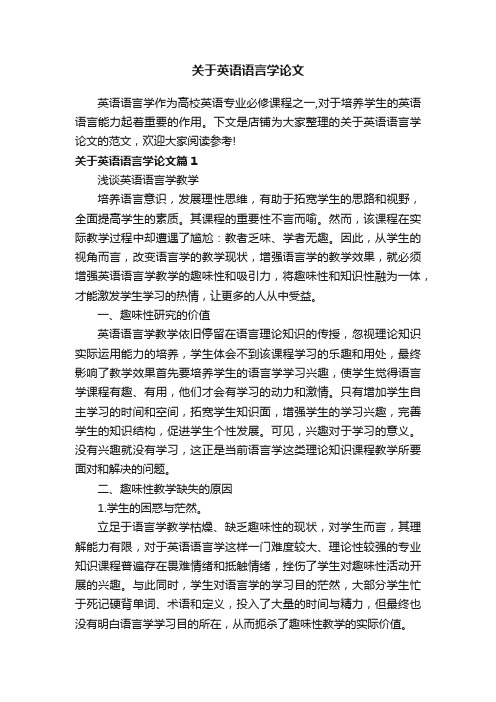
关于英语语言学论文英语语言学作为高校英语专业必修课程之一,对于培养学生的英语语言能力起着重要的作用。
下文是店铺为大家整理的关于英语语言学论文的范文,欢迎大家阅读参考!关于英语语言学论文篇1浅谈英语语言学教学培养语言意识,发展理性思维,有助于拓宽学生的思路和视野,全面提高学生的素质。
其课程的重要性不言而喻。
然而,该课程在实际教学过程中却遭遇了尴尬:教者乏味、学者无趣。
因此,从学生的视角而言,改变语言学的教学现状,增强语言学的教学效果,就必须增强英语语言学教学的趣味性和吸引力,将趣味性和知识性融为一体,才能激发学生学习的热情,让更多的人从中受益。
一、趣味性研究的价值英语语言学教学依旧停留在语言理论知识的传授,忽视理论知识实际运用能力的培养,学生体会不到该课程学习的乐趣和用处,最终影响了教学效果首先要培养学生的语言学学习兴趣,使学生觉得语言学课程有趣、有用,他们才会有学习的动力和激情。
只有增加学生自主学习的时间和空间,拓宽学生知识面,增强学生的学习兴趣,完善学生的知识结构,促进学生个性发展。
可见,兴趣对于学习的意义。
没有兴趣就没有学习,这正是当前语言学这类理论知识课程教学所要面对和解决的问题。
二、趣味性教学缺失的原因1.学生的困惑与茫然。
立足于语言学教学枯燥、缺乏趣味性的现状,对学生而言,其理解能力有限,对于英语语言学这样一门难度较大、理论性较强的专业知识课程普遍存在畏难情绪和抵触情绪,挫伤了学生对趣味性活动开展的兴趣。
与此同时,学生对语言学的学习目的茫然,大部分学生忙于死记硬背单词、术语和定义,投入了大量的时间与精力,但最终也没有明白语言学学习目的所在,从而扼杀了趣味性教学的实际价值。
2.教师的自我中心主义。
语言学教学无疑成了教师死板地给对学生灌输语言学术语的过程,学生丧失了发现问题、独立思考、平等交流的机会,其能力的培养自然无从谈起。
理论知识是研究人员和学者研究的成果和理论,包括专业知识、教育理论知识、关于人类发展的知识、指导课堂组织的理论知识、教学法知识、评价理论知识、社会文化知识,等等。
有关英语语言学论文例本

有关英语语言学论文例本对于英语语言学而言,在实际的英语学习以及英语研究的过程中是必不可少的一门学科,同时在实际的对于英语进行研究的过程中也能够起到较好的作用。
下文是店铺为大家整理的有关英语语言学论文例本的内容,欢迎大家阅读参考!有关英语语言学论文例本篇1浅析商务英语研究的功能语言学【摘要】近些年来,我国的经济发展呈现出迅猛的态势,因此商务的发展也在不断的进步。
由于我国对外贸易也在不断发展,所以我们对于商务英语的重视也必须要提升到一个新的高度。
商务英语的应用已经非常的普遍,我们要想更好的同国外进行交流和贸易,就必须要重视起商务英语的学习。
所以文章就将针对商务英语研究的功能语言学进行必要的分析和思考。
【关键词】商务英语;研究;功能;语言学最近几年,商务英语在我国的普及程度不断的提升,越来越多的人开始接触商务英语。
可是我国对于商务英语的研究和教学实际上还处于初步发展的阶段,并且也遇到了一些瓶颈性的问题。
理论方面研究的缺乏以及不深入成为了当前我国在商务英语研究方面遇到的最大问题。
所以我们必须努力的改善这种情况,解决这些问题,最为主要的就是利用功能语言学的分析系统,结合商务英语自身的特点,情景以及对外贸易和销售过程当中的语言特色,为商务英语教学的开展和研究提供一些可行的建议和意见。
一、商务英语语言学的体系以及相关概念商务英语是近些年伴随着经济不断发展,全球经济日益联系,应运而生的一种语言,它区别于普通的日常英语,主要就应用于对外的经济交流和贸易销售。
所以实际上这些年来商务英语已经成为了一种英语通用语,被越来越多的人学习和普及。
从语言学系统的角度来对商务英语进行分析,那么商务英语主要有以下的一些特点。
首先从语言环境来看,商务英语是专业的人员和大众进行语言沟通的一种语言工具。
其次就是专业人员在专业领域之内,进行专业内容交流的用语。
商务英语被包含于英语之内,有着英语的共性,但同时它也有明显的自身特点,独立于普通的英语语言。
英语语言学方面论文

英语语言学方面论文英语作为一种国际化的语言,在信息化、全球化日益发展的今天,其作用越来越重要。
下文是店铺为大家整理的关于英语语言学方面论文的范文,欢迎大家阅读参考!英语语言学方面论文篇1浅探新时代和谐英语语言学课堂的构建【摘要】探索一条有效的语言学教学途径一直是大学英语教育者关注的问题,本文从和谐的角度探讨英语语言学和谐课堂的构建。
分析什么是和谐课堂,进而利用和谐教学、和谐环境等理论方法指导语言学教学的实际,达到构建英语语言学和谐课堂的效果。
【关键词】英语语言学语言学课堂和谐课堂的构建良好的和谐的课堂气氛能激活学生的脑细胞,激发他们的学习兴趣,开发他们的思维潜能,更好地促进他们接受新知识,掌握新技能。
如何创造和谐的课堂气氛,有效地促进教学,是每个英语教学者都必然关注的问题。
美国心理学家罗杰斯认为:“成功的教学依赖于一种真诚的理解和信任的师生关系,依赖于一种和谐安全的课堂气氛。
”由此可见,一个成功的课堂与和谐安全的课堂气氛息息相关。
英语专业的学生在掌握了听说读写这些基本技能的基础上,需要进一步比较全面、比较系统地了解现代语言学这一领域的研究成果,以及一些最主要、最有影响的语言理论和原则,从而加深对人类语言这一人类社会普遍现象的理性认识,并具备一定的运用语言学理论解释语言现象、解决具体语言问题的能力,提高自身的语言修养和学习语言的能力。
一、英语语言学课程的特点课程的教学任务和目的是向学生讲授英语语言的属性、功能、起源和内部层次,掌握英语语言学基本特征和主要分支的基本概念,了解语言在时空中的变异及其与社会、文化、语境、思维等外部因素的关系,同时了解部分主要语言学流派。
英语语言学的教学内容宽泛,不易深细,主要包括英语语言和英语语言学领域中各分支的基础理论,如语音学、音系学、形态学、句法学、语义学、语用学等基本内容,也包括了语言的变异及其与外部因素的关系。
二、英语语言学的授课对象英语语言学教程的授课对象是学习英语的高等院校学生,因此在讲解过程中大部分采用了英语。
(语言学小论文)谈谈我身边的语言学现象
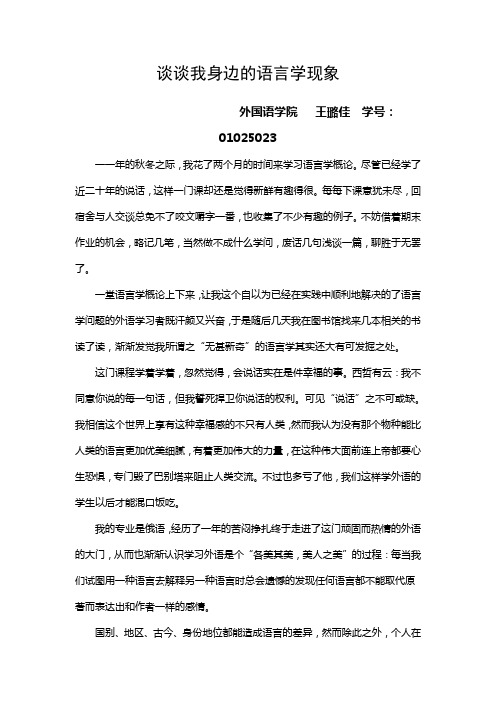
谈谈我身边的语言学现象外国语学院王璐佳学号:01025023 一一年的秋冬之际,我花了两个月的时间来学习语言学概论。
尽管已经学了近二十年的说话,这样一门课却还是觉得新鲜有趣得很。
每每下课意犹未尽,回宿舍与人交谈总免不了咬文嚼字一番,也收集了不少有趣的例子。
不妨借着期末作业的机会,略记几笔,当然做不成什么学问,废话几句浅谈一篇,聊胜于无罢了。
一堂语言学概论上下来,让我这个自以为已经在实践中顺利地解决的了语言学问题的外语学习者既汗颜又兴奋,于是随后几天我在图书馆找来几本相关的书读了读,渐渐发觉我所谓之“无甚新奇”的语言学其实还大有可发掘之处。
这门课程学着学着,忽然觉得,会说话实在是件幸福的事。
西哲有云:我不同意你说的每一句话,但我誓死捍卫你说话的权利。
可见“说话”之不可或缺。
我相信这个世界上享有这种幸福感的不只有人类,然而我认为没有那个物种能比人类的语言更加优美细腻,有着更加伟大的力量,在这种伟大面前连上帝都要心生恐惧,专门毁了巴别塔来阻止人类交流。
不过也多亏了他,我们这样学外语的学生以后才能混口饭吃。
我的专业是俄语,经历了一年的苦闷挣扎终于走进了这门顽固而热情的外语的大门,从而也渐渐认识学习外语是个“各美其美,美人之美”的过程:每当我们试图用一种语言去解释另一种语言时总会遗憾的发现任何语言都不能取代原著而表达出和作者一样的感情。
国别、地区、古今、身份地位都能造成语言的差异,然而除此之外,个人在语言方面的修养也起着重要作用。
伶牙俐齿者能自圆其说,铁齿铜牙者能嘻笑怒骂,笨嘴拙舌者则要遭抢白,正是这样的差别成就了不少文学作品中的经典。
譬如《红楼梦》中的晴雯一番冷嘲热讽竟就刺痛了一个家族一个时代。
每个人都有一套自己的哲学,同理也都有一套自己的语言学。
说话这件事,我们是要学一辈子的,不同的语言习惯就像一幅灵魂的肖像,展示着我们不同的性格,这在我们的生活中是随处可见的,下面我就略取几例来作证。
所谓贵人话语迟,在我们宿舍雪人(昵称)是一个典型的“贵人”。
语言学的毕业论文
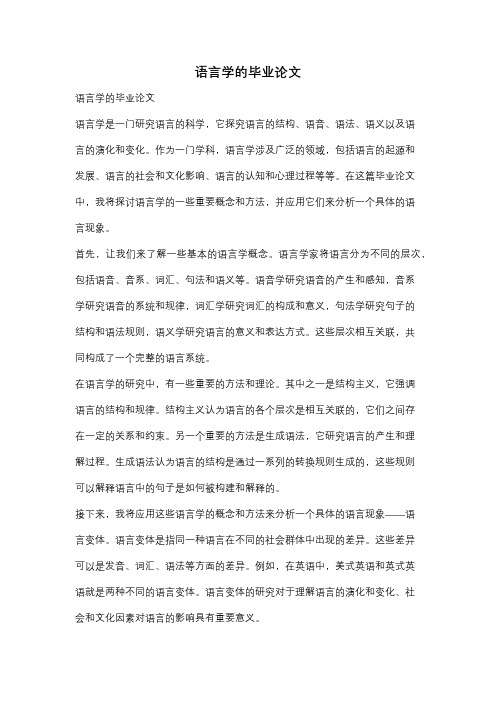
语言学的毕业论文语言学的毕业论文语言学是一门研究语言的科学,它探究语言的结构、语音、语法、语义以及语言的演化和变化。
作为一门学科,语言学涉及广泛的领域,包括语言的起源和发展、语言的社会和文化影响、语言的认知和心理过程等等。
在这篇毕业论文中,我将探讨语言学的一些重要概念和方法,并应用它们来分析一个具体的语言现象。
首先,让我们来了解一些基本的语言学概念。
语言学家将语言分为不同的层次,包括语音、音系、词汇、句法和语义等。
语音学研究语音的产生和感知,音系学研究语音的系统和规律,词汇学研究词汇的构成和意义,句法学研究句子的结构和语法规则,语义学研究语言的意义和表达方式。
这些层次相互关联,共同构成了一个完整的语言系统。
在语言学的研究中,有一些重要的方法和理论。
其中之一是结构主义,它强调语言的结构和规律。
结构主义认为语言的各个层次是相互关联的,它们之间存在一定的关系和约束。
另一个重要的方法是生成语法,它研究语言的产生和理解过程。
生成语法认为语言的结构是通过一系列的转换规则生成的,这些规则可以解释语言中的句子是如何被构建和解释的。
接下来,我将应用这些语言学的概念和方法来分析一个具体的语言现象——语言变体。
语言变体是指同一种语言在不同的社会群体中出现的差异。
这些差异可以是发音、词汇、语法等方面的差异。
例如,在英语中,美式英语和英式英语就是两种不同的语言变体。
语言变体的研究对于理解语言的演化和变化、社会和文化因素对语言的影响具有重要意义。
在研究语言变体时,我们可以使用一些特定的方法和工具。
其中之一是社会语言学调查,它通过调查问卷、访谈等方式收集语言使用者的数据。
这些数据可以用来分析不同社会群体之间的语言差异和变化。
另一个方法是语料库研究,它通过收集和分析大量的语言样本来揭示语言的规律和变化趋势。
这些方法和工具提供了一种系统和科学的方式来研究语言变体。
通过对语言变体的研究,我们可以了解语言的多样性和变化。
语言是人类的重要交流工具,它不仅仅是一种工具,更是一种文化和社会的表达。
有关语言学课程的论文范文
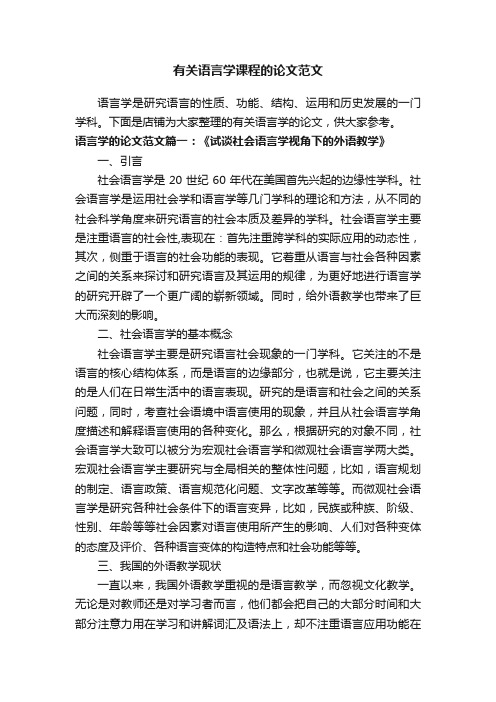
有关语言学课程的论文范文语言学是研究语言的性质、功能、结构、运用和历史发展的一门学科。
下面是店铺为大家整理的有关语言学的论文,供大家参考。
语言学的论文范文篇一:《试谈社会语言学视角下的外语教学》一、引言社会语言学是20世纪60年代在美国首先兴起的边缘性学科。
社会语言学是运用社会学和语言学等几门学科的理论和方法,从不同的社会科学角度来研究语言的社会本质及差异的学科。
社会语言学主要是注重语言的社会性,表现在:首先注重跨学科的实际应用的动态性,其次,侧重于语言的社会功能的表现。
它着重从语言与社会各种因素之间的关系来探讨和研究语言及其运用的规律,为更好地进行语言学的研究开辟了一个更广阔的崭新领域。
同时,给外语教学也带来了巨大而深刻的影响。
二、社会语言学的基本概念社会语言学主要是研究语言社会现象的一门学科。
它关注的不是语言的核心结构体系,而是语言的边缘部分,也就是说,它主要关注的是人们在日常生活中的语言表现。
研究的是语言和社会之间的关系问题,同时,考查社会语境中语言使用的现象,并且从社会语言学角度描述和解释语言使用的各种变化。
那么,根据研究的对象不同,社会语言学大致可以被分为宏观社会语言学和微观社会语言学两大类。
宏观社会语言学主要研究与全局相关的整体性问题,比如,语言规划的制定、语言政策、语言规范化问题、文字改革等等。
而微观社会语言学是研究各种社会条件下的语言变异,比如,民族或种族、阶级、性别、年龄等等社会因素对语言使用所产生的影响、人们对各种变体的态度及评价、各种语言变体的构造特点和社会功能等等。
三、我国的外语教学现状一直以来,我国外语教学重视的是语言教学,而忽视文化教学。
无论是对教师还是对学习者而言,他们都会把自己的大部分时间和大部分注意力用在学习和讲解词汇及语法上,却不注重语言应用功能在文化特征方面和社会实践方面的探究。
因此,使得学生对语言的运用能力整体都不合格,主要表现在不能用外语进行有效而流利的跨文化交际,不能将我国的传统文化真正传播出去。
语言学的毕业论文
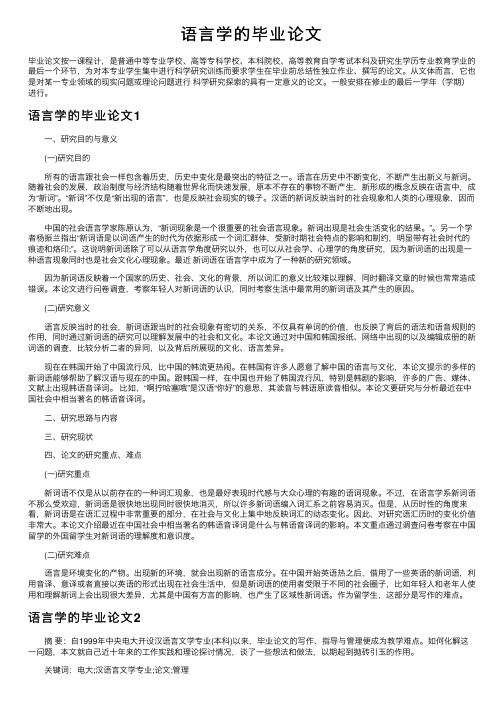
语⾔学的毕业论⽂毕业论⽂按⼀课程计,是普通中等专业学校、⾼等专科学校、本科院校、⾼等教育⾃学考试本科及研究⽣学历专业教育学业的最后⼀个环节,为对本专业学⽣集中进⾏科学研究训练⽽要求学⽣在毕业前总结性独⽴作业、撰写的论⽂。
从⽂体⽽⾔,它也是对某⼀专业领域的现实问题或理论问题进⾏科学研究探索的具有⼀定意义的论⽂。
⼀般安排在修业的最后⼀学年(学期)进⾏。
语⾔学的毕业论⽂1 ⼀、研究⽬的与意义 (⼀)研究⽬的 所有的语⾔跟社会⼀样包含着历史,历史中变化是最突出的特征之⼀。
语⾔在历史中不断变化,不断产⽣出新义与新词。
随着社会的发展,政治制度与经济结构随着世界化⽽快速发展,原本不存在的事物不断产⽣,新形成的概念反映在语⾔中,成为“新词”。
“新词”不仅是“新出现的语⾔”,也是反映社会现实的镜⼦。
汉语的新词反映当时的社会现象和⼈类的⼼理现象,因⽽不断地出现。
中国的社会语⾔学家陈原认为,“新词现象是⼀个很重要的社会语⾔现象。
新词出现是社会⽣活变化的结果。
”。
另⼀个学者杨振兰指出“新词语是以词语产⽣的时代为依据形成⼀个词汇群体,受新时期社会特点的影响和制约,明显带有社会时代的痕迹和烙印;”。
这说明新词语除了可以从语⾔学⾓度研究以外,也可以从社会学、⼼理学的⾓度研究,因为新词语的出现是⼀种语⾔现象同时也是社会⽂化⼼理现象。
最近新词语在语⾔学中成为了⼀种新的研究领域。
因为新词语反映着⼀个国家的历史、社会、⽂化的背景,所以词汇的意义⽐较难以理解,同时翻译⽂章的时候也常常造成错误。
本论⽂进⾏问卷调查,考察年轻⼈对新词语的认识,同时考察⽣活中最常⽤的新词语及其产⽣的原因。
(⼆)研究意义 语⾔反映当时的社会,新词语跟当时的社会现象有密切的关系,不仅具有单词的价值,也反映了背后的语法和语⾳规则的作⽤,同时通过新词语的研究可以理解发展中的社会和⽂化。
本论⽂通过对中国和韩国报纸、⽹络中出现的以及编辑成册的新词语的调查,⽐较分析⼆者的异同,以及背后所展现的⽂化、语⾔差异。
语言学毕业论文
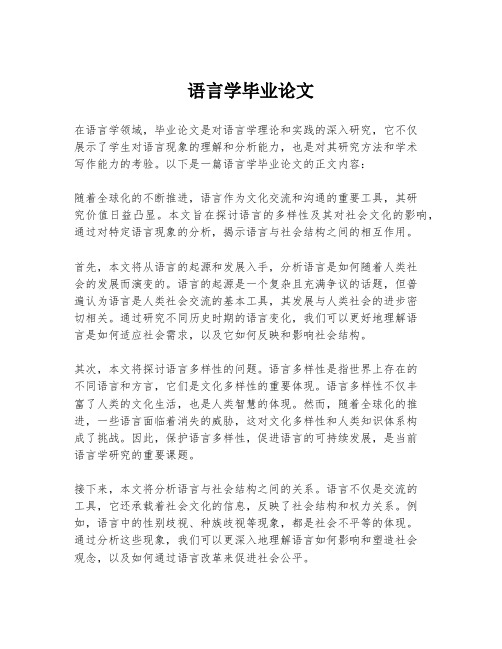
语言学毕业论文在语言学领域,毕业论文是对语言学理论和实践的深入研究,它不仅展示了学生对语言现象的理解和分析能力,也是对其研究方法和学术写作能力的考验。
以下是一篇语言学毕业论文的正文内容:随着全球化的不断推进,语言作为文化交流和沟通的重要工具,其研究价值日益凸显。
本文旨在探讨语言的多样性及其对社会文化的影响,通过对特定语言现象的分析,揭示语言与社会结构之间的相互作用。
首先,本文将从语言的起源和发展入手,分析语言是如何随着人类社会的发展而演变的。
语言的起源是一个复杂且充满争议的话题,但普遍认为语言是人类社会交流的基本工具,其发展与人类社会的进步密切相关。
通过研究不同历史时期的语言变化,我们可以更好地理解语言是如何适应社会需求,以及它如何反映和影响社会结构。
其次,本文将探讨语言多样性的问题。
语言多样性是指世界上存在的不同语言和方言,它们是文化多样性的重要体现。
语言多样性不仅丰富了人类的文化生活,也是人类智慧的体现。
然而,随着全球化的推进,一些语言面临着消失的威胁,这对文化多样性和人类知识体系构成了挑战。
因此,保护语言多样性,促进语言的可持续发展,是当前语言学研究的重要课题。
接下来,本文将分析语言与社会结构之间的关系。
语言不仅是交流的工具,它还承载着社会文化的信息,反映了社会结构和权力关系。
例如,语言中的性别歧视、种族歧视等现象,都是社会不平等的体现。
通过分析这些现象,我们可以更深入地理解语言如何影响和塑造社会观念,以及如何通过语言改革来促进社会公平。
此外,本文还将探讨语言政策和语言规划的问题。
语言政策是指政府或组织为管理语言使用而制定的规则和措施,而语言规划则是为了实现特定的语言目标而进行的系统规划。
在多语言社会中,合理的语言政策和规划对于维护社会和谐、促进文化交流具有重要意义。
本文将分析不同国家和地区的语言政策和规划案例,探讨其成功经验和面临的挑战。
最后,本文将总结语言在社会文化中的作用,并提出对未来语言学研究的展望。
有关语言学的论文

有关语言学的论文论文常用来指进行各个学术领域的研究和描述学术研究成果的文章,它既是探讨问题进行学术研究的一种手段,又是描述学术研究成果进行学术交流的一种工具。
论文一般由题名、作者、摘要、关键词、正文、参考文献和附录等部分组成。
论文在形式上是属于议论文的,但它与一般议论文不同,它必须是有自己的理论系统的,应对大量的事实、材料进行分析、研究,使感性认识上升到理性认识。
有关语言学的论文1随着社会的不断进步与发展,当前汉语言文学教学的现状不容乐观,存在教学模式因循守旧、教学方法和教学手段单一、教师综合素质不高等问题,严重影响了汉语言文学教学作用的发挥。
一、汉语言文学教学现状1、教学模式因循守旧在汉语言文学的教学中,许多学校的教师仍采用灌输式的教学方式,使学生被动地接受知识,导致“教”与“学”的效率难以提高。
久而久之,在枯燥、乏味的课堂教学中,学生学习的积极性和主动性被逐步削弱,甚至出现厌学情绪。
2、教学方法和教学手段单一以往教师在进行汉语言文学教学时,基本采用的都是填鸭式的教学方法。
由于教学方法过于单一,从而严重影响了学生学习汉语言文学的兴趣,致使教学效果不理想,加之教学中欠缺现代化教学手段的运用,教学质量一般。
3、教师综合素质有待于提高由于汉语言文学教师在实际教学过程中语言魅力的缺失,致使课堂气氛过于沉闷,从而使得学生配合教学的积极性较差,思维也被严重抑制。
在这一过程中,教材成了束缚学生自由发挥想象力的枷锁,诸多的语法、课文、词汇、阅读和写作等课程,使学生对汉语言学习产生出一种乏味和厌烦的感觉,这样必然会使教学效果大打折扣。
究其根本原因主要是由于教师的综合素质不高造成的。
为此,必须不断提高汉语言文学教师的综合素质。
二、汉语言文学教学改革的策略1、完善课程结构应按照社会发展对人才的要求,加大汉语言文学选修课的比重,并在为学生打下扎实专业功底的基础上,不断延伸、拓展学科范围,将一些与之相关专业的知识融入到汉语言文学教学内容当中,如哲学、史学、新闻学、公共关系学、美学、艺术、秘书学、国学以及影视等等。
- 1、下载文档前请自行甄别文档内容的完整性,平台不提供额外的编辑、内容补充、找答案等附加服务。
- 2、"仅部分预览"的文档,不可在线预览部分如存在完整性等问题,可反馈申请退款(可完整预览的文档不适用该条件!)。
- 3、如文档侵犯您的权益,请联系客服反馈,我们会尽快为您处理(人工客服工作时间:9:00-18:30)。
外国语学院英语语言学学期论文2011 至 2012学年度第2学期题目:任务型教学法在初中教学中的运用研究姓名: 陈琳琳年级:2009语言文学本1班学号:04010901292012年6月4号Research on Appliance of T ask-Based Approach in Junior High School Language T eaching Abstract:Task-based approach is focused on increasing the language application and communicative competence of the students on the basis of language meaning. Its success relies mainly on its feasibility, its necessity, its designed tasks as well as its teaching principles to be followed in the junior high school English teaching.Key words: task-based approach, Junior high school English teaching, language knowledge, language competenceWith the reform of new curriculum, it is very necessary and important to apply Task-based Language Teaching into the class. This thesis mainly focus on the analysis of the definition, feasibility and necessary, principles and the case design of task-based language teaching to help the teacher to apply the teaching method.1 The Comprehension of T ask-Based Language T eaching1.1 The Definition of a T askA task is an activity which requires learners to arrive at an outcome from given information through some process of thought, and which allows teachers to control and regulate that process.( Prabhu 1987:24)Some scholars believe that a task has four main components: a purpose, a context, a process and a product(Brownell1994:40). In writer's opinion, tasks are some activities which the things people do in everyday life, at work, at play, and in between.1.2 How to Design the T askBy now we have discussed the definitions of a task, then we will focus on designing the task.Breen(1987:25)suggests that teachers need to address four sets of questions when designing tasks:(1)What is the objectives of the task?(2)What is the content of the task?(3)How is the task to be carried out?(4) In what situation is the task to be carried out?With the answers to the above questions in mind, we will give some specific steps in designing tasks. There are basically five steps:Step 1 Think about the students' needs, interests, and abilities. What are the needs, interests, and abilities of the students? What kind of things do they like to do?Step 2 Brainstorm possible tasks. Brainstorms a list of communicative tasks for the topics listed in your textbooks that students may be interested in doing. Bear in mind that a task should have a communicative purpose and should be goal-oriented.Step 3 Evaluate the list. After you have brainstormed the possible tasks, you can use the following criteria to evaluate them. Educational value; Appropriateness to the students' needs, interests, and abilities; Availability of suitable resources; Time available.Step 4 Choose the language items. It needs two stages to analyse the language items required by the tasks. Firstly, Considering the level of linguistic difficulty in order to decided whether to accept, reject or modify a task that you originally planned. Secondly, when you have drawn up your final list of tasks. Y ou need to work out the possible language knowledge and skills needed to accomplish the task. If necessary, some exercise-tasks or pre-task language practice may be design to prepare students linguistically for the task.Step 5 Preparing materials. The students need to carry out the tasks in following with the materials.1.3 The Definition of T ask-Based Language TeachingTask-Based Language Teaching is, in fact, a further development of Communicative Language Teaching. It shares the same beliefs, as language should be learned as close as possible to how it is used in real life.2 Feasibility and Necessary of T ask-Based Approach2.1 FeasibilityTask-Based Approach emphasis the way of communication to learn how to communicate with others. Because the junior high school student have learned basicand simple words and phrases in the primary school, it is possible to communicate with other. For example, phatic communication---good morning, hello, how are you etc. What's more, it is beneficial for them to have the courage to practice oral English in daily life.2.2 NecessityTask-Based Approach put the practice chance for the students on the first place. It enhances the concept of new curriculum criteria. It can set some communicative environment for students. Besides, it provides more practice chance to improve the students' creativities and initiatives.3 Keeping the Principles of T ask-based Approach3.1 Centered-on StudentsThe core of Task-based Approach is centered-on students. Students should play the active and important roles in the class. The teacher should serves the students and pay more attention to process and development.3.2 interactionCommunication is the final purpose of language learning, and the core of communication is interaction. The importance of interaction mainly lies on producing the language automatically. In order to communicative successfully, People more draw their's attention on the expression of meaning and the comprehension of information than grammar and language form. Language interaction provide the opportunities for students about the information input and language output. Therefore, it is necessary to take advantage of the interaction of students and students, students and teachers in the teaching.3.3 Combining Learning in-Class with Applying Outside ClassLanguage's learning and practice have a close relationship. The goal of learning is to apply. The important significance of this combination lies on narrowing the distance between the class and society. Besides, it stimulate the students' inner motivation of learning language.3.4 Grade PrincipleThe design of tasks should adhere to these principles from simple to complex, from easy to difficult, deeper in levels to satisfy different abilities' students.4 Task-Based Case Design of Language T eaching4.1 Introduction of the Case DesignLast summer I acted as a English teacher in Sunwan village of xuchang city. I taught the students in Grade 9. The textbook is go for it . Besides, every unit prepares the class by some topics. I will choose one topic of the class to analyses the appliance of Task-Based Approach in junior high school language teaching. The topic is Greeting and introducing people. The text <the way American greet>Will as an example.4.2 Preparation of the T askDuring these years, china have a more frequent communication with foreign countries. So, Students will meet many foreigners in daily life. I make full use of the point and set some questions.Task 1 Brainstorm. Divide the students into several groups and ask the following questions to arouse the interest about this topic.(1)Can you tell me some experience for greeting?(2)How do you respond to the greeting?After their discussion, students will give different ideas. There are many opinions to express. Besides, the atmosphere of class become active.4.3 Implement and Guidance of the TaskTask 2 Fast reading and ask the students to finish the following questions.(1)why don't most Americans like using titles in introduction?(2)Why do Americans ask you some personal questions?Task 3 Detailed ReadingDiscussion in groups: ask the students to read the text fast and get the general idea of each paragraph. Guiding the students to learn to use the key words or phrasesto generalize the main idea.Task 4 Retell the passage according to the general idea.4.4 Reflection Stage of the T askTask 5 Reading the text again and discusses the cultural differences between China and America.5. ConclusionThe thesis mainly talk about the task's definition and how to design a task. Besides, focusing on the definition, its feasibility and necessity and principles of Task-Based language Teaching. What's more, Task-based Case Design of Language Teaching proves that Task-based approach is very practical and useful in the junior high school class. By the cooperation between the students and teacher, it not only make the class atmosphere active but also stir up the students' interests and improve their competence.References:[1] Breen,M.. Learners contribution to task design. 1987[2]王伟立."the opinion of foreign language teaching ". Foreign languages and their teaching. 2003: (9) 174[3] 王蔷. 英语教学法教程(第二版). 北京:高等教育出版社,2006.5。
